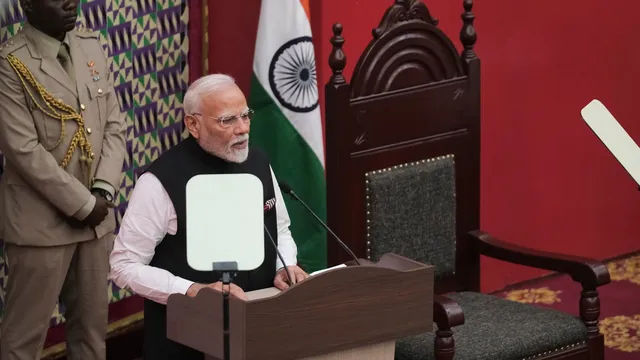
Narendra Modi strengthens ties during landmark Trinidad and Tobago visit
2025-07-04 20:07- Narendra Modi arrived in Trinidad and Tobago for a two-day official visit aimed at boosting investments.
- The visit seeks to strengthen ties in energy, health, and security sectors, with intentions to develop digital tools and agriculture.
- Modi's engagement has sparked support among Hindus but concerns from the Muslim community regarding religious intolerance.
Express your sentiment!
Insights
Trinidad and Tobago welcomed Indian Prime Minister Narendra Modi for his first official visit, which took place over two days. Modi's trip aimed to enhance investments in various sectors, including energy, health, and security, due to the shared historical connections between the two countries. The Caribbean nation is marked by a significant East Indian population, which constitutes over 35% of its 1.4 million residents, stemming from the colonial era when indentured workers were brought from India. Modi expressed excitement about forging stronger ties with Trinidad and Tobago prior to his arrival, showcasing the importance of their cultural connections. Upon landing, Modi was met with warm receptions from the Hindu community but faced criticism from certain Muslim organizations regarding his administration's record on religious tolerance. Trinidad and Tobago's Prime Minister Kamla Persad-Bissessar participated actively in the discussions and mentioned expected investments in medical, energy, and technology sectors, emphasizing a new dawn for cooperation. The talks included renewing trade and investment agreements, expanding exports from Trinidad and Tobago to India, and expressing mutual interest in enhancing digital tools and agriculture. Both leaders recognized the potential for enhanced cooperation, with Modi highlighting the importance of the global south in international dialogues. His address to the parliament underscored the commitment to placing human development at the center of trade relations, marking a significant moment for both nations in their colonial legacy and partnership moving forward. Modi's pledge to support the sixth generation of Indian origin citizens in Trinidad and Tobago by granting them Overseas Citizen of India cards also reflects deeper ties between the population of both countries. In summary, Modi's visit signifies the rekindled focus on fostering a strategic partnership between India and Trinidad and Tobago, providing opportunities to enhance diplomatic relations and economic ties focused on mutual respect, trust, and cultural fraternity.
Contexts
The history of Indian immigration to Trinidad and Tobago is a significant aspect of the nation’s demographic and cultural development. The initial wave of Indian immigrants arrived in the Caribbean islands in the 19th century, specifically between 1845 and 1917, primarily as indentured laborers. This migration was part of a broader pattern during the colonial period when British sugar plantations faced a severe labor shortage following the abolition of slavery in 1833. The British sought to address this deficiency by recruiting labor from India, partly due to the successful recruitment of free laborers in the region, and partly due to strategic interests in maintaining sugar production profitability. Over 147,000 Indians were brought to Trinidad and Tobago under this system, marking the beginning of a new ethnic community that would significantly shape the islands' cultural landscape. Upon arrival, Indian immigrants were subjected to a life of hard labor on sugar plantations, where they adapted to the harsh conditions and established a strong work ethic typical of their cultural background. They endured various challenges, including limited rights, cultural adjustments, and economic hardships. Nonetheless, they remained resilient, maintaining their religious and cultural practices, which were manifested in festivities, culinary traditions, and community structures. Hinduism and Islam became prominent religions among the Indian community, and this diversity enriched the multicultural tapestry of Trinidad and Tobago, leading to a unique blend of Indo-Caribbean identity. By the early 20th century, many Indians began to transition from plantation labor to self-sufficient farming and small businesses, contributing significantly to local economies. This created a shift in their social status and provided opportunities for upward mobility. The development of various enclaves across Trinidad and Tobago preserved cultural legacies, resulting in the establishment of temples, mosques, and community centers that fostered a sense of belonging and solidarity among the Indian diaspora. This period also saw the emergence of organizations aimed at advocating for the rights of Indian residents and addressing socio-political issues affecting their community, further integrating them into the fabric of national life. The legacy of Indian immigration is evident today in the socio-cultural dynamics of Trinidad and Tobago. Indian festivals such as Diwali and Eid are celebrated nationwide, reflecting the enduring influence of this ethnic group. The integration of Indian culinary practices into the national diet, characterized by dishes like roti and curried meats, showcases the lasting impact of this community. Moreover, as time progressed, intermarriage and cultural exchange between various ethnic groups in Trinidad and Tobago have further enriched the nation’s diversity. Understanding this history is critical for appreciating the multicultural identity of Trinidad and Tobago and recognizing the valuable contributions of Indian immigrants to the nation’s development.